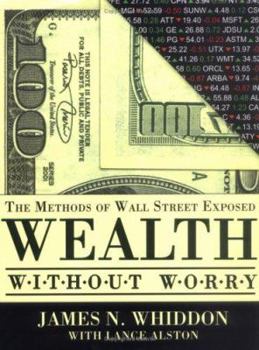Wealth Without Worry: The Methods of Wall Street Exposed
Select Format
Select Condition 
Book Overview
Between 2000 and 2002-the worst bear market since the Great Depression-investors lost trillions of dollars using Wall Street's failed methodologies. It didn't have to happen that way. Wealth Without... This description may be from another edition of this product.
Format:Hardcover
Language:English
ISBN:193328501X
ISBN13:9781933285016
Release Date:May 2005
Publisher:Brown Books Pub Group
Length:180 Pages
Weight:1.30 lbs.
Dimensions:9.3" x 0.8" x 7.3"
Customer Reviews
5 ratings
Wealth Without Worry
Published by Thriftbooks.com User , 18 years ago
I have read many books on retirement and investing and this is the FIRST book that made any sense, to me. It really simplifies how the stock market works and talks about all of the common pitfallls of investing that we have all tried and found that for the most part, they do not work. Instead of trying to time the market or use some other investment method, this book will tell you how to invest in 13-15,000 stocks and never worry about what the Dow 30 is doing, EVER. If you are interested in safe investing for growth or retirement income that will consistantly beat the Dow, without all the worry, then this is the book for you.
The easy way to wealth
Published by Thriftbooks.com User , 20 years ago
The book title says it all "Wealth without worry" easy to undestand,plenty of references and back-up data. Wish I had known about this system 20 years ago !
How to Beat Wall Street and "Own" Capitalism
Published by Thriftbooks.com User , 20 years ago
What intrigued me about this book is the fact that James N. Whiddon wrote it (with Lance Alston) "for investors who are frustrated with the constant barrage of confusing and conflicting investment information, hit-and-miss approaches, and exaggerated return claims. It was written for those who are tired of having the worries of their financial future rob them of their life's present. For all who ever thought the odds were stacked against them in the investing game, Wealth Without Worry will change all that." That is indeed a bold claim. Whether or not it proves true depends on several factors over which Whiddon has no control. They include an investor's willingness and ability to (a) absorb and digest the contents of this book, (b) identify her or his specific investment objectives, (c) rigorously evaluate or re-evaluate initiatives to-date to achieve those objectives, and then (d) make whatever adjustments may be necessary, not only of specific investment strategies and tactics but also of her or his own values, motives, personality, and character. Here are some of the questions to which Whiddon responds: 1. What are Wall Street's most popular methods of portfolio management? 2. Specifically what is active management? 3. Why and to what extent is active management misaligned with the best interests of individual investors? 4. When chasing returns, why do so many investors "arrive at the party late"? 5. What to consider before selecting the most appropriate investment help? 6. Which services should the advisor be required to provide? 7. How can the "Seven Essential Questions to Ask When Interviewing an Advisor" (pages 61-67) assist making an appropriate selection? 8. Why are "market returns there for the taking...by not succumbing to the Wall Street shell games"? 9. How to assemble and then manage a "proper portfolio" of investments? 10. Given the responses to the previous nine questions, which three action items should be pursued immediately? Why? In an article article published in the Dallas Morning News (July 31, 2005), Scott Burns notes that in their book, Whiddon and Alston "point out that a simple diversified index portfolio consisting of four basic index funds (20 percent S & P 500, 20 [percent Russell 2000, 20 percent MSCI EAFE and 40 percent Lehman intermediate government bond) would have returned 12.7 percent a year during the 25 years from 1979 through 2004." Burns goes on to explain why that's "a pretty good return." The 80:20 Market Return Portfolio which Whiddon and Alston recommend includes only 20% committed to fixed income. It "crushed" the returns earned by active managers, returning a "whopping" 14.29 percent...and did so with less market risk. The obvious conclusion is that an index portfolio will almost always outperform a managed portfolio because, as Alston explained to Burns, "With one quarter of the portfolio in one asset class, you might have a chance to outperform with one good fund. But with 15 asset cla
This is the book I have been waiting for!
Published by Thriftbooks.com User , 20 years ago
This book is a perfect read for both my wife and I. It is put in an easy to understand format that tells it like it is. After reading this book, you'll look at Wall Street differently. This is a must read for all investors!
Finally, an investment strategy that makes perfect sense.
Published by Thriftbooks.com User , 20 years ago
Finally someone is willing to take on Wall Street AND offer a viable investment strategy. It is easy to understand and I feel like I can apply its logic to my own money. I loved it!





